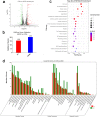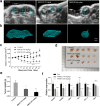4-Methoxydalbergione is a potent inhibitor of human astroglioma U87 cells in vitro and in vivo
- PMID: 33311599
- PMCID: PMC8379167
- DOI: 10.1038/s41401-020-00560-w
4-Methoxydalbergione is a potent inhibitor of human astroglioma U87 cells in vitro and in vivo
Abstract
Astroglioma is the most common primary tumor in the central nervous system without effective treatment strategies. Temozolomide (TMZ) is a chemotherapeutic drug to treat astroglioma but exhibits low potency and has side effects. Therefore, there is an urgent need to develop new compounds to treat astroglioma. Dalbergia sissoo Roxb was the source of Dalbergia odorifera in traditional Chinese medicine (TCM) and has been clinically used as an anti-tumor medicine. 4-Methoxydalbergione (4MOD) is purified from Dalbergia sissoo Roxb., and shows an inhibitory effect on osteosarcoma, but its effects on astroglioma have not been reported. Here, we evaluate its anti-astroglioma effects on both in vitro and in vivo models. In cultured astroglioma U87 cells, 4MOD inhibited cell proliferation and induced cell apoptosis in a time- and concentration-dependent manner. Compared with TMZ, 4MOD exhibited a tenfold greater potency of anti-astroglioma effects. 4MOD effectively stalled the cell cycle in G2 phase. Transcriptome sequencing (RNA-seq) showed that 4MOD upregulated 158 genes and downregulated 204 genes that are mainly enriched in cell membrane, cell division, cell cycle, p53, TNF, and MAPK signaling pathways, which may underlie its anti-tumor mechanisms. In a nude mouse xenograft model transplanted with U87 cells, 10 mg/kg 4MOD slowed down tumor growth rate, while at 30 mg/kg dose, it reduced tumor size. Collectively, this study demonstrates that 4MOD is a potent native compound that remarkably inhibits U87 astroglioma growth in both in vitro and in vivo models.
Keywords: 4‐methoxydalbergione; Dalbergia sissoo Roxb; RNA-seq; apoptosis; cell cycle; human astroglioma U87 cell line.
© 2020. CPS and SIMM.
Conflict of interest statement
The authors declare that they have no conflict of interest.
Figures





References
-
- National Pharmacopoeia Committee. Pharmacopoeia of the People’s Republic of China (part I). Beijing: China Medical Science and Technology Press; 2015. p. 229–30.
MeSH terms
Substances
LinkOut - more resources
Full Text Sources
Other Literature Sources
Research Materials
Miscellaneous

